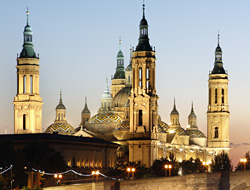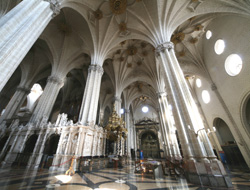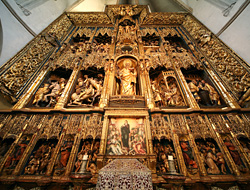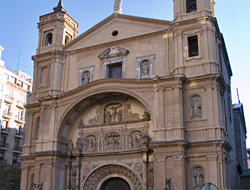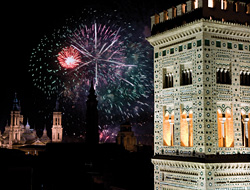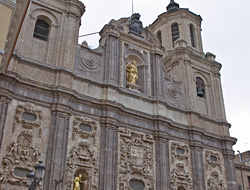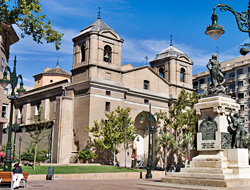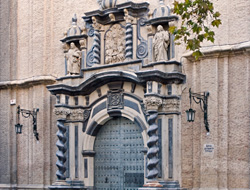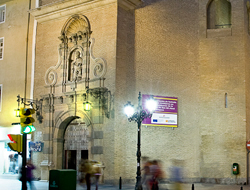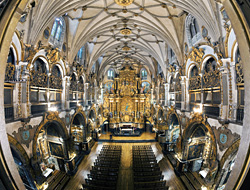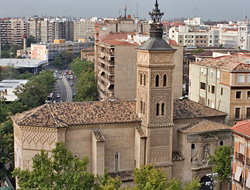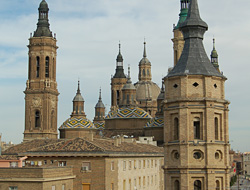Churches

Basílica de Nuestra Señora del Pilar
The Basílica del Pilar is the symbol of the city par excellence. Tradition holds that the Virgin Mary came to Zaragoza to the Apostle Saint James (Santiago), who was preaching on the banks of the Ebro, to console him. The Virgin gave him a jasper column as a symbol of the strength that he should demonstrate in his faith. Inside you will find an image of the Virgin resting on a Pillar (Pilar), the jasper column she is said to have given to the Apostle. The alabaster High Altarpiece still boasts some of its polychrome tiles, a spectacular example of Late Renaissance architecture, the work Damian Forment. Goya also left his mark on the temple, particularly on the dome, the setting for his fresco ``Queen of Martyrs``. A vast basilica of intense emotional resonance for local residents.
Catedral del Salvador o La Seo
It has been a Roman temple, Visigoth church, Mosque and finally a Cathedral, and thus showcases a range of contrasting artistic styles: Romanesque, Mudéjar, Renaissance, Gothic and Baroque. Also known as La Seo, particularly remarkable features include the Mudéjar wall of the parish, the Baroque tower and the Neoclassical façade. The main altarpiece, dedicated to El Salvador, is rendered in alabaster. The Chapter House houses the Tapestry Museum, an interesting tapestry collection spanning the 15th to the 18th centuries.
Iglesia de San Pablo
This temple is typical of a Mudéjar-style place of worship: a single aisleless nave with chapels set between the buttresses and a polygonal, five-sided chevet. The tower has an octagonal floor plan and a typical Mudéjar tower structure, with one tower set within another and a stairwell between the two. The exterior adornment, with Mudéjar motifs, was added only to the upper body. The interior is notable for the High Altarpiece, the work of Damian Forment.
Iglesia Basílica de Santa Engracia
As early as the 4th century Christians erected a temple of devotion on this site, which has undergone various transformations over the centuries. The magnificent Renaissance façade is the only remaining vestige of the original Monasterio Jerónimo de Sant Engracia. It is particularly notable for housing two marble paleochristian sarcophagi dating from the 4th century.
Iglesia parroquial de Santa María Magdalena
This 14th-century church stands on the site of a Roman temple. Renovation work in the 18th century saw the movement of the entrance to next to the former chevet. The church`s apse, decorated with overlapping mixtilinear arches framing pointed windows upon which multiple arms come together to form a rhombus shape, makes it representative of Mudéjar architecture. Both structurally and in terms of decorative motifs, the tower is similar to that of San Martín y el Salvador in Teruel.
Iglesia de Santa Isabel
The extremely beautiful, profuse, Churrigueresque-style façade is finished in white and dark alabaster, black marble and gilded plaster. Inside it is notable for the interplay of domes, which served as an example for the design of the Basílica del Pilar, as well as the elegant High Altarpiece. During Holy Week the procession of the Santo Entierro (Holy Burial) sets out from the church.
Iglesia Parroquial de Nuestra Señora del Portillo
Although its origin goes back to the time of the Reconquest, the current building dates from the 18th century. Due to its location next to one of the old city gates, it suffered serious damages during the War of Independence. Inside it is home to the Capilla de las Heroínas (Chapel of the Heroins), opened in 1908 as a tribute to the women who defended the city during the Siege. It also houses the relics of Santa Águeda, a festivity celebrated on 5 February.
Iglesia de San Felipe y Santiago el Menor
The façade, flanked by two Solomonic columns, features a delicate interplay between the figures of the two saints the church venerates. Its main gateway used to be part of the Basílica del Pilar. Inside, it stands out for the baldachin used for the High Altar, which follows the model designed by Bernini for the St. Peter`s Basilica in the Vatican.
Iglesia Parroquial de San Gil Abad
This Mudéjar style church was built in the 14th century, although a notable feature is the outer tower, dating from 1356. The floor plan is square in the lower floors and opens out into rectangles in the upper ones. The interior reflects the Baroque restoration, when a new entrance was created, resulting in the reorientation of the church. The sacristy is home to frescoes by Ramón Bayeu and seven paintings by Manuel Bayeu.
Iglesia del Real Seminario de San Carlos Borromeo
The sober, compact exterior of this building conceals an ornately decorated Baroque interior. The most notable feature is the main altarpiece, the work of brother Lacarre. Also of note is the colouring and the eighteen life-sized sculptures, which bear witness to the transition of the Baroque style towards Rococo.
Iglesia Parroquial de San Miguel de los Navarros
A medieval predecessor is known to have stood on the site of this church. The present-day church is of Mudéjar style and dates from the 14th century, though it was redeveloped and expanded in the Baroque style in the 17th century. Of particular note inside is the Renaissance altarpiece by sculptor Damnian Forment. A stone sculpture of Saint Michael the Archangel defeating Satan dominates the façade.
Iglesia de San Juan de los Panetes
Erected on the site of a former 18th-century church, the current Baroque temple`s interior was destroyed by a fire in 1935, which is why its walls have been smoothed out and whitewashed. The exterior stands out for the octagonal brick tower, which has a slight inclination that is clearly visible to passers-by.




